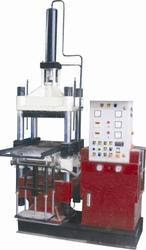Transfer Moulding
INTRODUCTION
Transfer moulding
In transfer moulding the rubber compound is pre heated in one part of the mold and forced into the closed cavity of the mold where the rubber is cured.
This process is use for making complicated shape products and rubber metal bonded items.
Compression moulding operates after mould closing operation whereas in transfer moulding it starts operating after the mould are already closed and then the material is transferred.Transfer moulding like compression moulding is a process where the amount of moulding material is measured and inserted before the moulding takes place.
Transfer moulding is a natural progression in the development when attempting to limit the disadvantages of compression moulding. The blank is loaded into a loading chamber and is then distributed into several cavities. The rubber is squeezed out of the loading chamber by means of the closing mechanism of the press itself, or with separate pistons, into each respective cavity.
This process is use for making complicated shape products and rubber metal bonded items.
Compression moulding operates after mould closing operation whereas in transfer moulding it starts operating after the mould are already closed and then the material is transferred.Transfer moulding like compression moulding is a process where the amount of moulding material is measured and inserted before the moulding takes place.
Transfer moulding is a natural progression in the development when attempting to limit the disadvantages of compression moulding. The blank is loaded into a loading chamber and is then distributed into several cavities. The rubber is squeezed out of the loading chamber by means of the closing mechanism of the press itself, or with separate pistons, into each respective cavity.
Working
In a very simple transfer moulding process required quantity of uncured rubber is pressed or transferred by a plunger operated pneumatically or by hydraulic press into the mould cavity to be cured with desired temperature and time.Hydraulic operated press offers better product consistency than pneumatic operated presses.
Since a plunger pushes the material into mould cavity this is also known as Plunger moulding and it is a variation on transfer moulding,where an auxillary ram exerts pressure on the material being moulded.This approach often performs better in fully automatic operation.Transfer moulding is widely used to enclose or encapsulate items such as coils,integrated circuits,plugs,connectors and other components.
Transfer moudling is having a piston and cylinder like device built into the mould so that the rubber is squirted into the cavity through small holes.A piece of uncured rubber is placed into a portion of the transfer mould called the pot. The mould is closed and under hydraulic pressure the rubber is forced trough a small hole into the cavity.
The mould is held closed while the rubber cures.The plunger is raised up and the transfer pad material may be removed and thrown away.The transfer mould is opened and the part can be removed.The flash and the gate may need to be trimmed.Another key point is that a premeasured amount of elastomeric compound can be placed in the heating chamber.
The moulds remain closed until the curing reaction within the material is complete.Ejector pins are usually incorporated into the design of the making tool and are used to push the part from the mould once it is hardened.Ejector pins provide a vital role in ejecting the moulded material from press.Some cases multiple ejector pins are also designed for better release.These types of moulding are usitable for high production runs as they have short prodcution cycle.Transfer moulding unlike compression moulding uses a closed mould so smaller tolerances adn more intricate parts can be achieved.
The fixed cost of the tooling in transfer moulding is greater than in compression moulding and as both methods produce waste material, whether it be flash or the material remaining in the sprue and runners,transfer moulding is the more expensive process.
Multiple ejector Pins
Resin transfer moulding:
In the composite industry ,fiber reinforced composited are often manufactured by a process called Resin transfer moulding.Layers of textile preforms generally long fibers woven or knitted in patterns are pre arranged in the mould.The resin is then injected to impregnate the performs.A built in vacuum is often installed to avoid air bubbles and help draw the resin into the cavity.Resings,that are used in the process has to be relatively low in viscosity.In the semiconductor industry package encapsulation is usuallly done with transfer moulding due to the high accuracy of transfer moulding tooling and low cycle time of the process.
New transfer mould designs integrated with suitable surface treatments like MiCC and H Cr plating are becoming more popular in the industry .Some common Products more popular in the industry.Some common products are utensils handles,electric applicance parts, electronic component,and connectors.Although transfer moulding can also be used for thermoplastic kind of materials but the majority can also be used for thermoplastic kind of materials but the majority of the materials used in this process are still thermosets.
Advantages:
1.shorter cure times.
2.Better rubber to metal bonding
3.Easy location of metal inserts.
4.Low flash loss
2.Better rubber to metal bonding
3.Easy location of metal inserts.
4.Low flash loss
5.The preparation of blanks and their handling is made considerably easier
Disadvantages:
1. High mold cost
2.High mold weight
3.Longer change over time between cures.
4.Parts with textile inserts cannot be produced.
5. Production speed lower than injection moulding.
2.High mold weight
3.Longer change over time between cures.
4.Parts with textile inserts cannot be produced.
5. Production speed lower than injection moulding.








Comments
Post a Comment